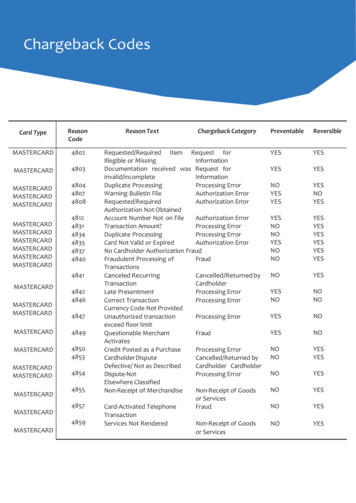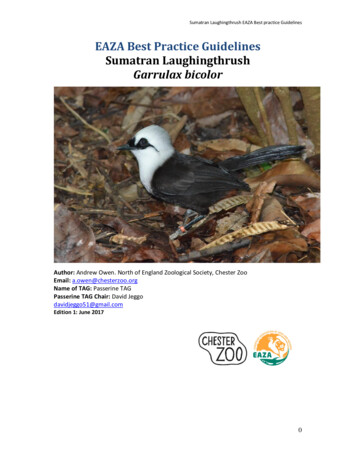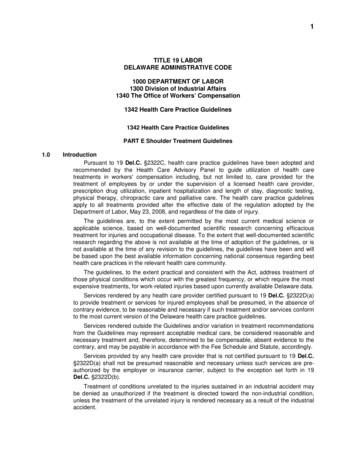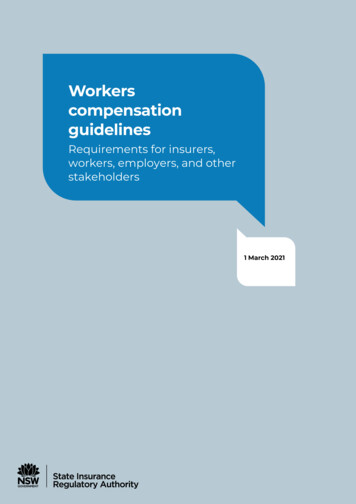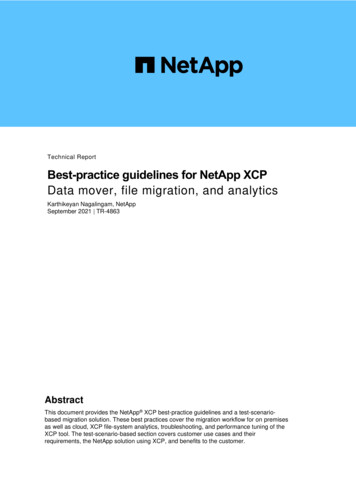
Transcription
Technical ReportBest-practice guidelines for NetApp XCPData mover, file migration, and analyticsKarthikeyan Nagalingam, NetAppSeptember 2021 TR-4863AbstractThis document provides the NetApp XCP best-practice guidelines and a test-scenariobased migration solution. These best practices cover the migration workflow for on premisesas well as cloud, XCP file-system analytics, troubleshooting, and performance tuning of theXCP tool. The test-scenario-based section covers customer use cases and theirrequirements, the NetApp solution using XCP, and benefits to the customer.
TABLE OF CONTENTSIntroduction . 4NetApp XCP . 4Data move or migration . 4File system analytics . 4Delete . 5Live source migration support. 5Prerequisites for XCP . 5Migration workflow . 6On premises . 6Cloud . 6File analytics . 8Deployment steps . 10Test bed details . 10Steps for deployment. 11Sizing guidelines . 14Time estimate based on testing . 14Comparing XCP 1.6.1 to XCP 1.5 . 15Performance tuning . 17Customer scenarios . 17Data lake to ONTAP NFS . 17High-performance computing to ONTAP NFS . 18Using the XCP data mover to migrate millions of small files to flexible storage . 19Using the XCP data mover to migrate large files . 19Duplicate files . 20Specific date-based scan and copy of data . 20Creating a CSV file from an SMB/CIFS share . 21Data migration from 7-Mode to ONTAP . 22CIFS data migration with ACLs from a source storage box to ONTAP . 40Best practices and recommendations . 48Troubleshooting . 48Error 1: XCP Failed with nfs3 error 70: stale filehandle Error in the xcp.log . 48Error 2: NetApp NFS Destination Volume Has Space, but XCP Failed with nfs3 error 28: no space left ondevice . 48Where to find additional information . 482Best-practice guidelines for NetApp XCP 2021 NetApp, Inc. All Rights Reserved.
Version history . 49LIST OF TABLESTable 1) Test bed details. . 10Table 2) Deployment steps. 11Table 3) Azure NetApp Files service levels and performance details. . 17Table 4) Transitioning 7-Mode SMB storage to ONTAP. . 39Table 5) Migrating CIFS data with ACLs from a source storage box to ONTAP. 40LIST OF FIGURESFigure 1) XCP data migration and replication. . 4Figure 2) NetApp XCP file analytics communication from the GUI. . 5Figure 3) Migration workflow from any NAS to NetApp NAS. . 6Figure 4) Migration workflow from on premises to cloud. . 7Figure 5) Data mover solution for on premises to Azure without ExpressRoute. . 7Figure 6) XCP file analytics flow. . 8Figure 7) Results of the XCP copy operation. . 14Figure 8) Results of the XCP sync – rename and links operations. . 14Figure 9) Results of the XCP sync - append and delete operations. . 15Figure 10) Results of the XCP sync performance for XCP 1.6.3 versus 1.7 (with 8K size of one million files). . 15Figure 11) Results of the XCP sync performance for XCP 1.6.1 versus 1.5 (with 16K size of one million files). . 16Figure 12) Results of the XCP sync performance for XCP 1.6.1 versus 1.5 (with 1MB size of one million files). . 16Figure 13) NetApp data mover solution for MapR cluster using XCP. . 18Figure 14) Data migration from on premises to Azure NetApp Files for small files. . 19Figure 15) Data migration from on premises to Azure NetApp Files for large files. . 193Best-practice guidelines for NetApp XCP 2021 NetApp, Inc. All Rights Reserved.
IntroductionThis document provides the NetApp XCP best-practice guidelines and a test scenario-based solution.These best practices cover the migration workflow for on premises as well as cloud, file-systemanalytics, troubleshooting, and performance tuning of the XCP. The test-scenario-based sectioncovers customer use cases and their requirements, the NetApp solution using XCP, and benefits tothe customer.NetApp XCPNetApp XCP transfers data by using multithreads and customizable features. It is designed for threemajor use cases: data move or migration, file-system analytics, and fast directory tree deletion.Data move or migrationThe NetApp XCP transfers data from any NAS to NetApp NAS. This process consists of four majoroperations: scan, copy, sync, and verify. There are some additional features that help the datamonitoring and transfer: Scan: Provides a high-level layout of NAS data. Copy: Performs a baseline data transfer. Sync: Performs the incremental data transfer. Verify: Performs a thorough verification of the target. (Optional) Show: Discovers the NAS shares.Figure 1 illustrates the XCP data migration and replication operations.Figure 1) XCP data migration and replication.File system analyticsNetApp XCP natively provides the ability to identify, scrutinize, and analyze unstructured data toimprove insights—a key requirement for enterprise customers who want to use those insights forbetter planning, to operationalize high-value digital assets, and for data governance through reportingand assessment.Customers who deal with sensitive data can use NetApp XCP to answer typical operational questions,such as: Where is my data? How much data and what types of files do we have?4Best-practice guidelines for NetApp XCP 2021 NetApp, Inc. All Rights Reserved.
What data is actively used and how much is dormant?Figure 2 illustrates the NetApp XCP file analytics communication from the GUI.Figure 2) NetApp XCP file analytics communication from the GUI.DeleteIt is very challenging for storage teams and Electronic Design Automation (EDA) workloads to cleanup large directories—whether it’s stale data or test data that needs to be cleaned to recover storagespace. XCP provides a fast delete functionality that can be used to delete a complete directory tree.The NetApp XCP Delete function removes files and folders from a given NAS path. You can leveragethe match filters to delete a specific set of files and folders. For a large number of files and folders,you can use the Force option, which does not require a confirmation to delete.Live source migration supportThe live source migration support included in XCP 1.7 allows migration from the data source that is inactive use (read and write activity). XCP leaves out the files that are being used when the migrationjob such as copy and sync are running, and the skipped files information is captured in the XCP log.This feature supports the changes on the source and does not support changes on the destination.During the migration, the destination is expected to be not active. Live Source Migration support isavailable for NFS migrations only.Note:Special settings are not required for Live Source Migrations.Prerequisites for XCPBefore you deploy NetApp XCP, the following prerequisites must be met:1. Verify the NFS ports used by the NFS server by running the following command:rpcinfo -p NAS IPor on-prem nfs data LIF ip 2. To access where you execute the XCP operations such as on-premises or cloud instances (forexample, Azure/AWS/Google virtual machine [VM] instances), open the firewall ports for the NFSports.3. Verify that the NFS port is accessible from the XCP server by using telnet on-prem nfs dataLIF ip or NAS IP 2049. The default port is 2049. If your environment has different port,use that IP.4. For NFS, verify that the shares are accessible from the XCP server by using showmount -e NAS IP .5. Increase the number of inodes on the destination volume to more than the file count ( number offiles) on the source files.6. Download the XCP license from the NetApp XCP License Portal.a. You must have a NetApp account in mysupport.netapp.com, or you can register for free.5Best-practice guidelines for NetApp XCP 2021 NetApp, Inc. All Rights Reserved.
b. Download the license and have it ready.7. Create one NFS share on premises, Azure NetApp volume, or Cloud Volume Service (premiumservice level) in cloud for XCP catalog.8. Create a NAS volume and configure the share for the destination of your data.9. For multiple XCP instances, you must have one or more servers or cloud instances to transfer thedata from multiple source folders or files to the destination.10. The maxdir size (default is 308MB) defines the maximum file count (approximately one million) ina single folder. Increase the maxdir size value to increase the file count. Increasing the value willhave an impact on additional CPU cycle.11. In cloud, NetApp recommends that you have ExpressRoute (Azure), Direct Connect (AWS), orCloud Interconnect (GCP) between on premises and cloud.Migration workflowMigration has different phases to follow for better planning and completing the migration. To migratedata from a third-party NAS storage or directly attached NAS exported storage using NetApp XCP,follow the migration guidelines provided in this section.Figure 3 illustrates the migration workflow from any NAS to NetApp NAS.Figure 3) Migration workflow from any NAS to NetApp NAS.On premisesThe migration workflow from any NAS to NetApp NAS includes the following steps:1. Discover the NAS shares and data.2. Scan the data and produce a report to find the layout of the data.3. Create a baseline by running the XCP Copy command. For faster migrations, select more XCPinstances and split the workload at the subfolder level to initiate parallel migration jobs.4. For incremental updates, use XCP sync until the change rate is low for the cutover window.5. Mark the source as read-only to perform a final sync by running the XCP sync command tocomplete the migration.6. To verify that the data transferred correctly, compare the source and destination by running thexcp verify command.CloudFor cloud, you can follow the similar on-premises migration workflow. If the connectivity between onpremises and cloud is direct connect (AWS) or ExpressRoute (Azure) or cloud interconnect (GCP).6Best-practice guidelines for NetApp XCP 2021 NetApp, Inc. All Rights Reserved.
Figure 4 illustrates migration workflow from on premises to cloud.Figure 4) Migration workflow from on premises to cloud.If there is no direct internet connection between on premises to cloud, you must transfer the data fromon premises to cloud through an offline data transport method such as truck. Each cloud serviceprovider has a different method and different terminology to move the data to their data center.Figure 5) Data mover solution for on premises to Azure without ExpressRoute.Figure 5 represents a data mover solution for on premises to Azure. You can use a similararchitecture with respective components from respective cloud service providers components.7Best-practice guidelines for NetApp XCP 2021 NetApp, Inc. All Rights Reserved.
File analyticsThe NetApp XCP file analytics GUI helps to run file system scans by using XCP at the back end andvisualizing statistics such as graphs and views for any NAS (NFS, SMB) file system. Starting in 1.6,XCP can be run as a service with the help of simple deployment steps by using Configure andsystemctl options. The XCP Configure option guides you to install and configure Postgres and webserver as well as collect credentials. The systemctl option runs XCP as a service for REST APIcommunications from the GUI.Figure 6 illustrates the XCP file analytics flow.Figure 6) XCP file analytics flow.Note:For more information about the XCP file analytics high-level architecture, GUI-baseddashboard views such as stats view, and file distribution view details, see the NetApp XCP1.6 Delivers Open File Analytics and Infrastructure Improvements blog.In XCP 1.6, there is a limited GUI for customized graphs. To create the required graphs, you canleverage the CLI by running the xcp scan command with matching filters. See the followingexamples.1. Generate a list of files modified beyond a year by using xcp scan and -match filter with the spaceconsumed.[root@ch-vm-cent7-2 linux]# ./xcp scan -match "modified 1*year" -l -q192.168.89.110:/ifs/data for analysis modified morethan yearXCP 1.6P1; (c) 2020 NetApp, Inc.; Licensed to Karthikeyan Nagalingam [NetApp Inc] until WedSep 9 13:19:35 2020xcp: WARNING: CPU count is only 1!Filtered: 1 did not matchXcp command : xcp scan -match modified 1*year -l -q 192.168.89.110:/ifs/data for analysis5,055 scanned, 5,054 matched, 0 errorSpeed: 1.10 MiB in (510 KiB/s), 110 KiB out (49.5 KiB/s)Total Time : 2s.STATUS: PASSED[root@ch-vm-cent7-2 linux]#[root@ch-vm-cent7-2 linux]# cat modified morethan yearrwxr-xr-x --- 7056 5030512 7y99ddata for analysis/benchmarks/benchmarks/udf TOBAGandTOTUPLE 7 benchmark.out/6/ SUCCESSrwxr-xr-x --- 7056 503270 8.50KiB 7y99ddata for analysis/benchmarks/benchmarks/udf TOBAGandTOTUPLE 7 benchmark.out/6/part-r-00000rw-r--r-- --- 7056 5030512 7y58ddata for analysis/benchmarks/benchmarks/udf TOBAGandTOTUPLE 7 benchmark.out/6/SUCCESS.crcrw-r--r-- --- 7056 503270 8.50KiB 7y99ddata for analysis/benchmarks/benchmarks/udf TOBAGandTOTUPLE 7 benchmark.out/6/out original8Best-practice guidelines for NetApp XCP 2021 NetApp, Inc. All Rights Reserved.
rw-r--r-- --- 7056 503270 8.50KiB 7y99ddata for analysis/benchmarks/benchmarks/udf TOBAGandTOTUPLE 7 benchmark.out/6/out sortedrwxr-xr-x --- 7056 5030512 7y99ddata for analysis/benchmarks/benchmarks/udf TOBAGandTOTUPLE 7 benchmark.out/2/ SUCCESSrwxr-xr-x --- 7056 50390 8.50KiB 7y99ddata for analysis/benchmarks/benchmarks/udf TOBAGandTOTUPLE 7 benchmark.out/2/part-r-00000 console output removed due o page space size 2. Find the space used by files that are more than one year old.[root@ch-vm-cent7-2 linux]# ./xcp -du -match "modified 1*year"192.168.89.110:/ifs/data for analysis/XCP 1.6.1; (c) 2020 NetApp, Inc.; Licensed to Karthikeyan Nagalingam [NetApp Inc] until WedSep 9 13:19:35 2020xcp: WARNING: CPU count is only 1!52.5KiB data for analysis/benchmarks/benchmarks/Macro Scope 1 benchmark.out28.5KiB data for analysis/benchmarks/benchmarks/CollectedGroup 6 benchmark.out28.5KiB data for analysis/benchmarks/benchmarks/Foreach 11 benchmark.out153KiB data for analysis/benchmarks/benchmarks/SecondarySort 9 benchmark.out412KiB data for analysis/benchmarks/benchmarks/CoGroupFlatten 6 benchmark.out652KiB data for analysis/benchmarks/benchmarks/Iterator 1 benchmark.out652KiB data for analysis/benchmarks/benchmarks/LoaderDefaultDir 1 benchmark.out652KiB data for analysis/benchmarks/benchmarks/Order 4 benchmark.out28.5KiB data for analysis/benchmarks/benchmarks/MapPartialAgg 4 benchmark.out/228.5KiB data for analysis/benchmarks/benchmarks/CastScalar 11 benchmark.out/21.29MiB data for analysis/benchmarks/benchmarks/Order 18 benchmark.out652KiB data for analysis/benchmarks/benchmarks/FilterBoolean 5 benchmark.out20.5KiB data for analysis/benchmarks/benchmarks/Macro DefinitionAndInline 5 benchmark.out/2628KiB data for analysis/benchmarks/benchmarks/Types 29 benchmark.out console output removed due o page space size 3.18MiB data for analysis/benchmarks/benchmarks/hadoop10340KiB data for analysis/benchmarks/benchmarks/Split 5 benchmark.out5.90GiB data for analysis/benchmarks/benchmarks6.56GiB data for analysis/benchmarks6.56GiB data for analysisFiltered: 488 did not matchXcp command : xcp -du -match modified 1*year 192.168.89.110:/ifs/data for analysis/Stats: 5,055 scanned, 4,567 matchedSpeed: 1.10 MiB in (1.36 MiB/s), 110 KiB out (135 KiB/s)Total Time : 0s.STATUS: PASSED[root@ch-vm-cent7-2 linux]#3. Find the total size and graphical view of data that was modified more than one year ago.[root@ch-vm-cent7-2 linux]# ./xcp -stats -match "modified 1*year" -html192.168.89.110:/ifs/data for analysis/ modified morethan year stats.htmlXCP 1.6.1; (c) 2020 NetApp, Inc.; Licensed to Karthikeyan Nagalingam [NetApp Inc] until WedSep 9 13:19:35 2020xcp: WARNING: CPU count is only 1!Xcp command : xcp -stats -match modified 1*year -html 192.168.89.110:/ifs/data for analysis/Stats: 5,055 scanned, 4,567 matchedSpeed: 1.10 MiB in (919 KiB/s), 110 KiB out (89.1 KiB/s)Total Time : 1s.STATUS: PASSED[root@ch-vm-cent7-2 linux]#The following report is an example custom scan of files that were modified more than one yearago.9Best-practice guidelines for NetApp XCP 2021 NetApp, Inc. All Rights Reserved.
Deployment stepsTest bed detailsTable 1 provides the details of the test bed that was used for this deployment and performancevalidation.Table 1) Test bed details.Solution ComponentsDetailsXCP version 1.7 One Linux server - Linux (RHEL 7.9); you can use RHEL 8 One windows server – Windows server 2019 standardNetApp AFF storage array HA pair forSource Volume AFF8080 NetApp ONTAP 910Best-practice guidelines for NetApp XCP 2021 NetApp, Inc. All Rights Reserved.
Solution ComponentsDetails NFS protocolNetApp AFF storage array HA pair forDestination Volume AFF A800 ONTAP 9 NFS protocolFujitsu PRIMERGY RX2540 serverEach equipped with: 48 CPUs Intel Xeon 256GB physical memory 10GbE dual portNetworking10GbESteps for deploymentTo deploy NetApp XCP for data transfer, complete the following steps:1. Meet the prerequisites as detailed in the Prerequisites for XCP section.2. Download the XCP software from the NetApp XCP (Downloads) page.3. Install and activate the XCP software on the destination location. You can also review the detailsin NetApp XCP User Guide.Table 2) Deployment steps.OperationRemarksInstallCopy thedownloaded XCPtar files to the XCPserver.Untar the tarfile.Download thelicense.Activate thelicense.Get the NFSportFind the sourceNFS port anddestination NFSserver. The defaultport is 2049Check theNFSconnectionCheck the NFSserver (bothsource anddestination) byusing telnet to theNFS server port.CatalogconfigurationCreate an NFSvolume and exportNFS for XCP11Best-practice guidelines for NetApp XCPSample commands# scp Documents/OneDrive\ -\ NetApp\Inc/XCP/software/1.6.1/NETAPP XCP 1.6.1.tgzroot@10.63.150.53:/usr/src[root@mastr-53 src]# tar -zxvf NETAPP XCP 1.6.1.tgzDownload the license fromhttps://xcp.netapp.com/license/xcp.xwic and copy to the XCPserver.[root@mastr-53 linux]# ./xcp activate[root@mastr-53 src]# cp 3 src]# cd /usr/src/xcp/linux/[root@mastr-53 linux]# ./xcp activate[root@mastr-53 ]# rpcinfo -p 10.63.150.213[root@mastr-53 ]# rpcinfo -p 10.63.150.63[root@mastr-53 ]# telnet 10.63.150.127 2049[root@mastr-53 ]# telnet 10.63.150.63 2049A800-Node1-2:: volume create -vserver Hadoop SVM -volumexcpcatalog -aggregate aggr Hadoop 1 -size 50GB -stateonline -junction-path /xcpcatalog -policy default -unixpermissions ---rwxr-xr-x -type RW -snapshot-policy default-foreground true 2021 NetApp, Inc. All Rights Reserved.
OperationRemarkscatalog. You canalso leverageoperating systemNFS export forXCP catalog.Check the NFSexport.Update xcp.ini.Sample commandsA800-Node1-2:: volume mount -vserver Hadoop SVM -volumexcpcatalog vol -junction-path /xcpcatalog[root@mastr-53 ]# showmount -e 10.63.150.63 grep xcpca/xcpcatalog (everyone)[root@mastr-53 ]# cat /opt/NetApp/xFiles/xcp/xcp.ini# Sample xcp config[xcp]catalog 10.63.150.64:/xcpcatalog[root@mastr-53 ]#Source NASexportsFind the sourceNAS exports byusing xcp show.[root@mastr-53 linux]# ./xcp show 10.63.150.127 NFS Exports check here Attributes of NFS Exports check here Look for: NFS Exports Attributes ofNFS Exports (Optional)Scan(Optional) Scanthe source NASdata.[root@mastr-53 linux]# ./xcp scan -newid xcpscantest4 stats 10.63.150.127:/xcpsrc volScan the source NAS data. it’s good to do that to understand the data layout and find anyissues for the migration. The XCP scanning operation time is propostional to the number ofmillions of files and directory depths. You can skip the scanning if you are familiar withyour NAS dataReportcheckCheck the reportcreated by xcpscan—mainlyunreadable foldersand unreadablefiles.(Optional)ChangeinodeView the numberof inodes andmodify it based onthe number of filesto migrate or copyfor both catalogand destinationvolumes (ifrequired).ScandestinationvolumeScan thedestinationvolume.CheckspaceCheck the sourceand destinationvolume space.12Best-practice guidelines for NetApp XCP[root@mastr-53 linux]# mount 10.63.150.64:/xcpcatalog/xcpcatalogbase) nkarthik-mac-0: karthikeyannagalingam scp pscantest4Documents/OneDrive\ -\ NetApp\ Inc/XCP/customers/reports/A800-Node1-2:: volume show -volume xcpcatalog -fieldsfiles,files-usedA800-Node1-2:: volume show -volume xcpdest -fieldsfiles,files-usedA800-Node1-2:: volume modify -volume xcpcatalog -vserverA800-Node1 vs1 -files 2000000Volume modify successful on volume xcpcatalog of VserverA800-Node1 vs1.A800-Node1-2:: volume show -volume xcpcatalog -fieldsfiles,files-used[root@mastr-53 linux]# ./xcp scan -stats10.63.150.63:/xcpdest[root@mastr-53 ]# df -h /xcpsrc vol[root@mastr-53 ]# df -h /xcpdest/ 2021 NetApp, Inc. All Rights Reserved.
OperationRemarksCopyCopy the data fromsource todestination byusing xcp copyand check thesummary.Sample commands[root@mastr-53 linux]# ./xcp copy -newidcreate Sep091599198212 10.63.150.127:/xcpsrc vol10.63.150.63:/xcpdest command inprogress results removed Xcp command : xcp copy -newid create Sep091599198212 parallel 23 10.63.150.127:/xcpsrc vol10.63.150.63:/xcpdestStats: 9.07M scanned, 9.07M copied, 118 linked,9.07M indexed, 173 giantsSpeed: 1.57 TiB in (412 MiB/s), 1.50 TiB out (392MiB/s)Total Time : 1h6m.STATUS: PASSED[root@mastr-53 linux]#Note: By default, XCP creates seven parallel processes to copy the data. This can be tuned.Note: NetApp recommends that the source volume be read only. In real time, the source volume is a live,active file system. The xcp copy operation might fail because NetApp XCP does not support a livesource that is continuously changed by an application.For Linux, XCP requires an Index ID because XCP Linux performs cataloging.(Optional)Check theinodesCheck the inodeson the destinationNetApp volume.A800-Node1-2:: volumefiles,files-usedvservervolume-------------- ------A800-Node1 vs1 xcpdestshow -volume xcpdest -fieldsfilesfiles-used-------- ---------21251126 15039685A800-Node1-2:: Incrementalupdate orcutoffPerform theincremental updateby using xcpsync.[root@mastr-53 linux]# ./xcp sync -idcreate Sep091599198212Xcp command : xcp sync -id create Sep091599198212Stats: 9.07M reviewed, 9.07M checked at source, nochanges, 9.07M reindexedSpeed: 1.73 GiB in (8.40 MiB/s), 1.98 GiB out (9.59MiB/s)Total Time : 3m31s.STATUS: PASSEDFor this document, in order to simulate real-time, the one million files on the source data were renamedand then the updated files were copied to the destination by using xcp sync.For Windows, XCP needs both source and destination paths.Validate thedata transferYou can validatethat the source anddestination havethe same data byusing xcpverify.Xcp command : xcp verify 10.63.150.127:/xcpsrc vol10.63.150.63:/xcpdestStats: 9.07M scanned, 9.07M indexed, 173 giants,100% found (6.01M have data), 6.01M compared, 100%verified (data, attrs, mods)Speed: 3.13 TiB in (509 MiB/s), 11.1 GiB out (1.76MiB/s)Total Time : 1h47m.STATUS: PASSEDXCP documentation provides multiple options (with examples) for the scan, copy, sync, and verifyoperations. For more information, see the NetApp XCP User Guide.Note:Windows customers should copy the data by using access control lists (ACLs). NetApprecommends using xcp copy -acl -fallbackuser\ username fallbackgroup\ username or groupname source destination . Tomaximum performance, considering the source volume that has SMB data with ACL and thedata accessible by both NFS and SMB, the target must be NTFS volume. Using XCP (NFSversion), copy the data from the Linux server and execute the XCP (SMB version) sync withthe -acl and -nodata options from the Windows server to copy the ACLs from source datato the target SMB data.For detailed steps, see Configuring 'Manage Auditing and Security Log' Policy.13Best-practice guidelines for NetApp XCP 2021 NetApp, Inc. All Rights Reserved.
Sizing guidelinesThis section provides the approximate time to perform the XCP copy and XCP sync operations with adifferent file size of one million files for NFS.Time estimate based on testingThe tests for the XCP copy and sync operations used the same test bed that was used for thedeployment. One million files of three sets of 8K, 16K, and 1MB files were created and the changeswere performed in real time. The XCP sync function performs the differential incremental updatesfrom the source to the target at the file level. The incremental update operation is one or more ofthese four operations: rename existing files and folders, append data to existing files, delete files andfolders, and include additional hard, soft, and multilinks. For test purposes, we focused on therename, append, delete, and links operations. In other words, the modification operations such asrename, append, and d
major use cases: data move or migration, file-system analytics, and fast directory tree deletion. Data move or migration The NetApp XCP transfers data from any NAS to NetApp NAS. This process consists of four major operations: scan, copy, sync, and verify. There are some additional features that help the data monitoring and transfer:

